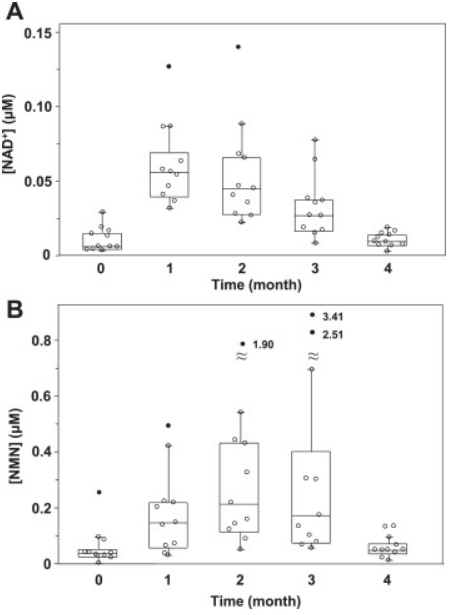This new study found that for the first time that NMN supplementation in humans increases levels of NMN in blood plasma.
“Oral NMN intake increased the plasma levels of NAD+ and NMN. Elevation levels of the plasma NMN differed greatly among the participants. The serum insulin levels after meals increased by NMN intake. No adverse symptoms were observed during NMN administration.”
Key Points
- Oral NMN increased plasma levels of NAD+ and NMN.
- All previous studies with NMN and NR have not been able to detect measurable increase in blood levels of NMN or NR.
- They also found increased levels of NAD+ and insulin levels.
Nicotinamide Mononucleotide (NMN) Intake Increases Plasma NMN and Insulin Levels in Healthy Subjects
- 11 subjects received 250 mg a day for 3 months.
- Blood tests were done monthly 2 hours after lunch.
With this, they were able to measure increased NMN in plasma for the first time.
- NAD+ also increased, as did Insulin levels.
- Peak for all was at month 2, slightly decreasing at month 3.
- All returned to baseline 1 month after stopping supplementation.

Quotes From The Research
Healthy volunteers received 250 mg of NMN once a day in the morning (n = 11) for 12 weeks, and the plasma concentrations of NMN and NAD+ were measured monthly. Physiological and laboratory tests were performed within two hours after lunch (at 2 pm) before and during NMN administration
Oral administration of NMN increased the plasma concentrations of NMN and NAD+, and the postprandial serum insulin levels.
The mean insulin concentration was initially 6.95 μIU/mL, increased significantly by 5-fold to 39.2 μIU/mL after two months of NMN administration, and then decreased to 28.1 μIU/mL after three months of NMN administration
The mean triglyceride concentration increased from 80.8 mg/dL to 186 mg/dL after two months of NMN administration, and reduced to 155 mg/dL after two months of NMN administration although this change in triglyceride concentration was not significant
As shown in Fig. 3A, the plasma NAD+ concentration increased significantly 1, 2, and 3 months after the beginning of the NMN administration, and then returned to the initial levels one month after the ending of the NMN ingestion.
Importantly, we successfully measured the plasma NMN concentration for the first time to our knowledge. Figure 3B shows the change in the plasma NMN concentration during the oral administration of NMN. The plasma NMN concentration increased significantly as the NMN ingestion continued, and the peak concentration was found 2 months after the beginning of the NMN administration. The NMN concentration returned to the initial levels one month after the ending of the NMN intake. It should be noted that two participants showed very high NMN concentration at month 2 and/or 3 without no adverse symptoms.
In fact, the plasma NAD+ concentration (Fig. 3A) was about 100-fold smaller than that of the blood NAD+ concentration [28].
On the other hand, the plasma NMN concentration (Fig. 3B) was about 10-fold higher than that of the blood NMN concentration [28].
Okabe et al [28] reported that oral administration of NMN for 12 weeks did not change the NMN concentration in the whole blood. This study clearly showed that oral intake of NMN increased significantly the plasma NMN concentration.
Two participants showed very high elevation of the plasma NMN concentration compared to other participants (Fig. 3B), suggesting that there is a large difference in absorption efficiency of NMN.
These results indicate that plasma NMN measurement may lead to the early detection of Parkinson’s disease in patients with pre-existing diseases.
In this study, the postprandial blood insulin levels increased significantly after ingestion. The increase in insulin levels has not been previously observed in clinical trials of NMN ingestion, probably because fasting blood insulin concentrations were measured in the previous studies.
It is reported that treatment with NMN increases this insulin secretion [6, 34].
Mechanistically, cyclic-ADP ribose (cADPR) is produced from NAD+ by CD38 cyclase activity, and cADPR increases the intracellular calcium ion concentration, thereby promoting insulin secretion [35].
The results of previous studies and the present study suggest that insulin secretion in the presence of glucose may be enhanced by NMN ingestion. Therefore, long-term NMN ingestion may increase the duration and amount of postprandial insulin secretion.
